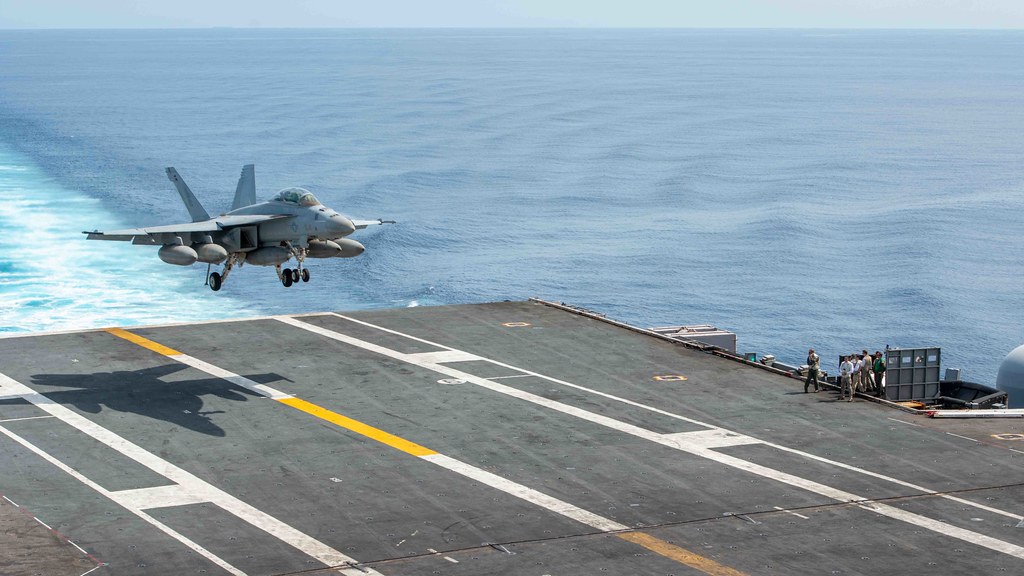The difficulty of landing on a US aircraft carrier explained by a Spanish engineer
All pilots say that the hardest part of a flight is the landing. However, landing strips on the mainland are often several kilometers long.
Things change drastically when we talk about an aircraft carrier, whose flight decks are much shorter than a conventional runway. To give us an idea, the large aircraft carriers of the United States Navy have a length of 333 meters (in the case of the Nimitz class) and 337 meters (in the case of the new class Gerald R. Ford). These aircraft carriers have oblique landing strips (a post-war British invention) that allow planes to take off and land simultaneously. These anding strips measure about 200 meters.

There are only two models of combat aircraft currently in operation that are designed to land on such short runways without any assistance: the Harrier II and the F-35B, which are STOVL aircraft, that is, they they can take off on very short runways and land vertically. However, the Nimitz and Ford class aircraft carriers do not use this type of aircraft, but other aircraft designed to land and take off conventionally but which have also been reinforced (structurally and in their landing gear) and equipped with arresting hooks to be able to land on aircraft carriers, such as the F/A-18E/F Super Hornet and the F-35C. The US is not the only country that uses aircraft carriers of this type: they are also used by France, Russia and communist China.

So that the planes embarked on these aircraft carriers can land without leaving the runway, these large aircraft carriers are equipped with arresting wires. The Nimitz-class carriers have four, except for the last two (USS Ronald Reagan and USS George H.W. Bush, which have three), and the Ford-class have three. These wires, made of steel, are separated from each other by about 15 meters and their function is to stop the plane when it lands on the flight deck. It is a risky operation, because at the moment of landing, the plane accelerates in case it fails to catch up and it has to take off again, which in aeronautical terms is known as a "touch-and-go", although in the US Navy they know it as "bolter".

For naval aviators (as the US Navy knows their pilots), the ideal is to hook the third stop cable (in aircraft carriers that have four) or the second (in those that have three) . To do this, the plane has to land at a certain angle on a moving ship. Added to this difficulty is the complexity of controlling air traffic on an aircraft carrier where planes may be landing and taking off constantly.
The Spanish aerospace engineer Sergio Hidalgo has published an interesting and very complete video in which he explains these issues, after a visit to the aircraft carrier USS George H.W. Bush, invited by NATO (the video is in Spanish, you can activate the automatic subtitles in English in the bottom bar of the player):
---
Main photo: US Navy. An F/A-18F Super Hornet of Strike Fighter Squadron (VFA) 94 "Mighty Shrikes" landed on the aircraft carrier USS Nimitz (CVN 68) on January 14, 2023 in the waters of the South China Sea.
|
Don't miss the news and content that interest you. Receive the free daily newsletter in your email: |
- Most read
- The 'hole' without civil flights around Paris during the opening of the Olympic Games
- Stunning footage of the F-15QA Ababil in flight recorded from its cockpit
- The firearms used by the Pontifical Swiss Guard, the smallest army in the world
- Eurofighter vs F-35: the opinions of professional pilots on these advanced fighters
- The first photo of an F-16 fighter with Ukrainian insignia and the details it has revealed
- The most distant deployment of the Spanish Air Force in Australia and New Zealand
- This is the driver station of an M1 Abrams tank and the impressive start of its engine

 ES
ES







Opina sobre esta entrada: